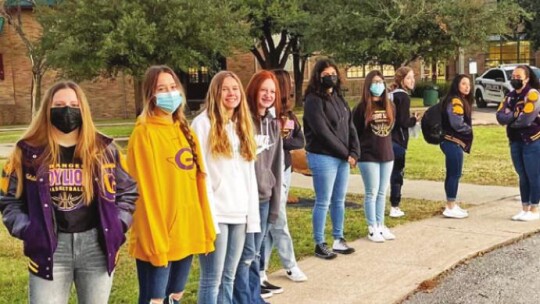Closing school was a measure of last resort, but Granger ISD students are back in class this week and plan to stay there.
“We are doing everything in our power to make sure that we keep in-person education,” said Superintendent Jeni Neatherlin, “because we know that is vital to the school district and to the families and the community members of Granger.”
Last week, Neatherlin spoke about the state of Granger ISD as it relates to the COVID-19 pandemic. The discussion came during a two-day school closure, Jan. 20-21. Although incoming winter weather played a factor in the pause in schedule, increases in local COVID-19 cases were a root cause.
“We had a lot of staff out, we had a lot of students out,” said Neatherlin. “We are still having teachers steadily test positive over this break.”
The hardship didn’t make the decision to close schools any easier. As they counted their cards, school staff examined how they were doing in required time to be in school.
The Texas Education Code requires districts and charter schools to operate for a minimum of 75,600 minutes. The bill also allows school districts and charter schools to add minutes as necessary to compensate for minutes of instruction lost due to school closures caused by extreme weather conditions or other calamities.
“We have 10 days on our calendar that we are over on minutes,” said Neatherlin. “When I was looking at the situation, … you are only allowed to apply for 4,200 minutes of waver days. That’s nine days for low attendance waivers. Between last August and early September and these last two weeks in January, we have hit our nine, and so, where I’m going to have to apply for a waiver.”
In addition to her reasons as a superintendent, Neatherlin also has teaching experience to fall back on.
“Because I was a teacher for a long time, my reasons as a teacher is that we’re not delivering any new content because we have so many kids that are missing,” said Neatherlin, “and with COVID right now we already have so many gaps, and so if a teacher’s teaching something new that day and they’ve already had so many kids that are missing without that initial instruction which is so important right now, so everything is just a big catch up right, and it’s just like a big Whac-A-Mole.”
As a result, the reprieve gave everyone some time to reflect on the situation.
“If I’m thinking like a new teacher,” said Neatherlin, “we can take a couple of days, get with the kids that are absent, catch them up, talk to them a little bit while they’re at home and figure out what we can do and regroup.”
As planned, school resumed Monday, Jan. 24.
“Our staff is just ready and raring to go. We are doing everything in our power to make sure that we keep inperson education because we know that is vital to the school district and to the families and the community members of Granger,” said Neatherlin. “Other districts might not be doing this, but the “I” in ISD, this is what’s best for us right now.”
Looking back and forward
Like other districts, Granger ISD’s decisions come as they manage effects of the Omicron variant of the COVID-19 virus. In the fall, the Delta variant also made impacts on staff and student attendance.
‘We powered through it essentially,” said Neatherlin. “We have to been very, very fortunate to be able to staff up until recently. It’s hard.”
Granger ISD has taken sanitization measures, cleaning procedures and other steps to slow the spread of the virus. Aiding in that effort was the announcement by Gov. Greg Abbott in October 2020 of the COVID-19 Rapid Testing Pilot Program.
Through the pilot program, the Texas Division of Emergency Management provided participating school systems with COVID-19 rapid antigen tests to administer to students, teachers and staff who choose to participate. Schools enrolled in the program also received personal protective equipment (PPE) to safely administer the rapid tests, which produce reliable results within 15 minutes. Granger ISD was one of the eight pilot schools chosen for the program
“We have been testing all along, up until this last week,” said Neatherlin. “There was a couple of days where we weren’t able to get the tests in due to supply chain breaks.”
Local school districts might get a reprieve soon. Superintendents have received health authorities that the peak rise of cases was scheduled for Jan. 20, which has now passed. While the overall number of cases will still rise, the rate of increase should decrease.
“Anybody who looks at data from historically in January to the months of March/April, that is the trend,” said Neatherlin in reference to last year.
In the meantime, Granger’s superintendent has maintained communication with parents to apprise them of case numbers, testing statistics and trying to be as transparent as possible.
“We are not going be a school district that’s steadily shuts down for this,” said Neatherlin. “We know that we made this decision to kind of regroup on some of the attendance absences and getting kids where they need to be, and so what we plan to do is we plan to just really work to support our kids on being here.”
The biggest message Granger ISD has for students is to come to school. With the campus being a focal point for a community of families and elderly citizens, the school wants to make sure they take care of students and those around them.
“Our hope is that we’re just going to continue. We’re going to resume and in the event that we have a few weather things that happen, we still have additional days that as far as our calendar that we can maneuver,” said Neatherlin. “Our last resort is to close schools. That is absolute last resort.”






